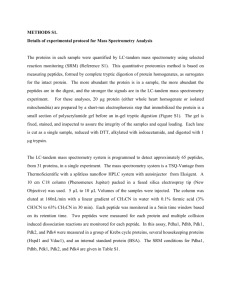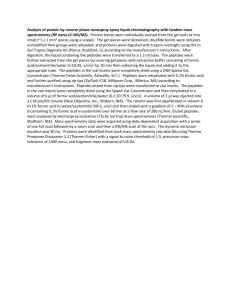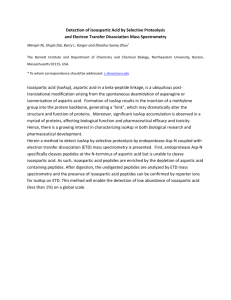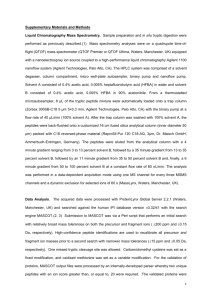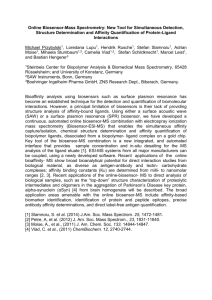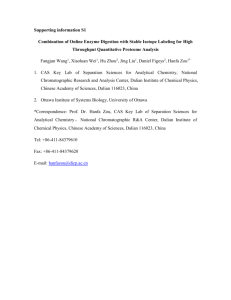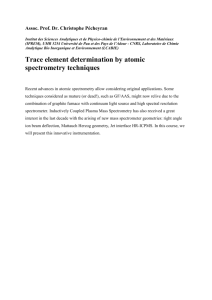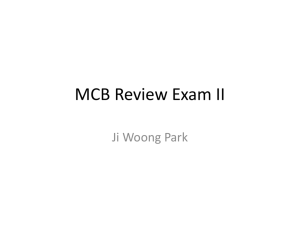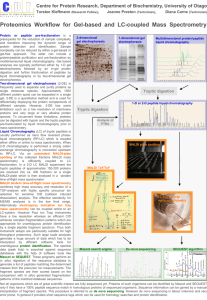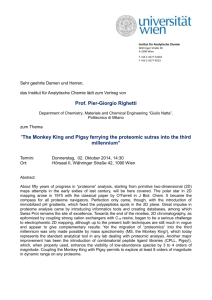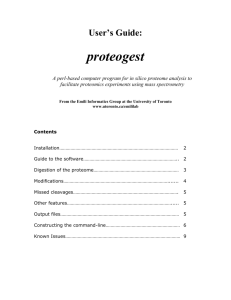Supplementary Materials and Methods (doc 34K)
advertisement
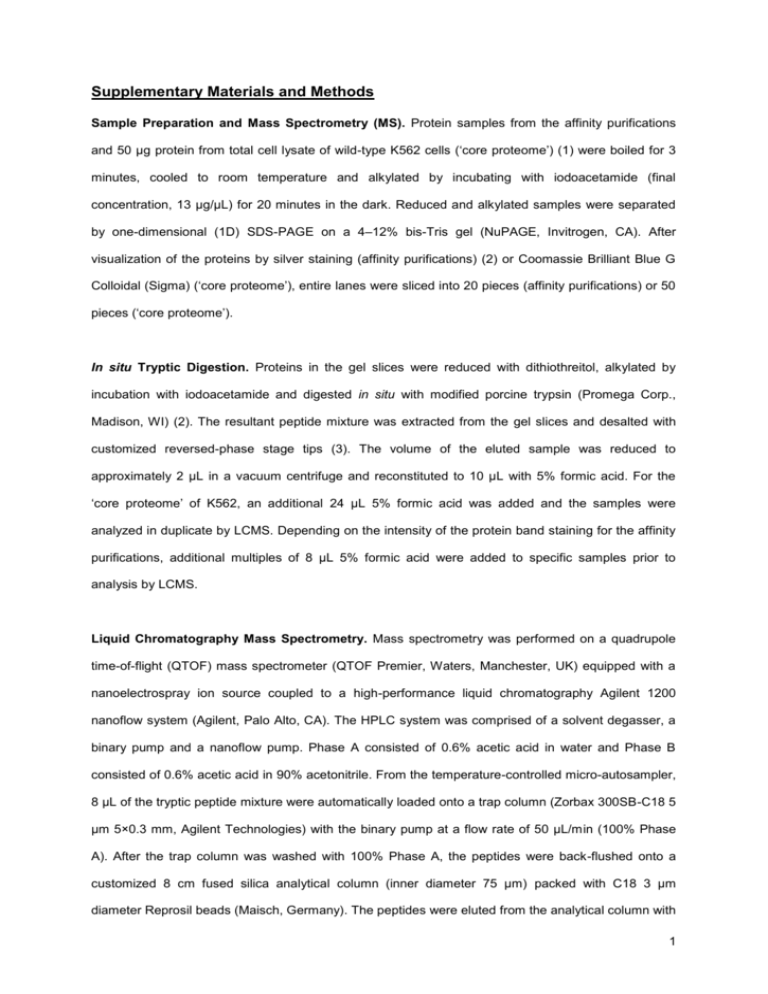
Supplementary Materials and Methods Sample Preparation and Mass Spectrometry (MS). Protein samples from the affinity purifications and 50 µg protein from total cell lysate of wild-type K562 cells (‘core proteome’) (1) were boiled for 3 minutes, cooled to room temperature and alkylated by incubating with iodoacetamide (final concentration, 13 µg/µL) for 20 minutes in the dark. Reduced and alkylated samples were separated by one-dimensional (1D) SDS-PAGE on a 4–12% bis-Tris gel (NuPAGE, Invitrogen, CA). After visualization of the proteins by silver staining (affinity purifications) (2) or Coomassie Brilliant Blue G Colloidal (Sigma) (‘core proteome’), entire lanes were sliced into 20 pieces (affinity purifications) or 50 pieces (‘core proteome’). In situ Tryptic Digestion. Proteins in the gel slices were reduced with dithiothreitol, alkylated by incubation with iodoacetamide and digested in situ with modified porcine trypsin (Promega Corp., Madison, WI) (2). The resultant peptide mixture was extracted from the gel slices and desalted with customized reversed-phase stage tips (3). The volume of the eluted sample was reduced to approximately 2 µL in a vacuum centrifuge and reconstituted to 10 µL with 5% formic acid. For the ‘core proteome’ of K562, an additional 24 µL 5% formic acid was added and the samples were analyzed in duplicate by LCMS. Depending on the intensity of the protein band staining for the affinity purifications, additional multiples of 8 µL 5% formic acid were added to specific samples prior to analysis by LCMS. Liquid Chromatography Mass Spectrometry. Mass spectrometry was performed on a quadrupole time-of-flight (QTOF) mass spectrometer (QTOF Premier, Waters, Manchester, UK) equipped with a nanoelectrospray ion source coupled to a high-performance liquid chromatography Agilent 1200 nanoflow system (Agilent, Palo Alto, CA). The HPLC system was comprised of a solvent degasser, a binary pump and a nanoflow pump. Phase A consisted of 0.6% acetic acid in water and Phase B consisted of 0.6% acetic acid in 90% acetonitrile. From the temperature-controlled micro-autosampler, 8 µL of the tryptic peptide mixture were automatically loaded onto a trap column (Zorbax 300SB-C18 5 µm 5×0.3 mm, Agilent Technologies) with the binary pump at a flow rate of 50 µL/min (100% Phase A). After the trap column was washed with 100% Phase A, the peptides were back-flushed onto a customized 8 cm fused silica analytical column (inner diameter 75 µm) packed with C18 3 µm diameter Reprosil beads (Maisch, Germany). The peptides were eluted from the analytical column with 1 a 25 minute gradient ranging from 13 to 35% Phase B, followed by a 3 minute gradient from 35 to 50% Phase B and a 4 minute gradient from 50 to 100% Phase B at a constant flow rate of 250 nL/min. The analysis was performed in a data-dependent acquisition mode using one MS channel for every three MSMS channels and a dynamic exclusion for selected ions of 60 s (MassLynx, Waters, Manchester, UK). MS Data Processing. The acquired data were processed with ProteinLynx Global Server 2.2.1 (Waters, Manchester, UK) and searched against an internally-curated version of the International Protein Index human protein sequence database (IPI version 3.32, European Bioinformatics Institute, www.ebi.ac.uk/IPI/) (4) with the search engine MASCOT (5). This compilation of entries from SwissProt, TrEMBL, RefSeq, and Ensembl was appended with frequently-observed non-human contaminants. Submission to MASCOT was via a Perl script that performs an initial search with broad mass tolerances on both the precursor and fragment ions (200 ppm and 0.15 Da, respectively). High confidence peptide identifications were used to recalibrate all precursor and fragment ion masses prior to a second search with narrower mass tolerances (13 ppm and 0.035 Da). One missed tryptic cleavage site was allowed. Carbamidomethyl cysteine was set as a fixed modification, and oxidized methionine was set as a variable modification. Results from the database search of each gel slice were parsed into EpiCenter (Proxeon Biosystems, Odense, Denmark). Criterion for positive protein identification was identification of a minimum of two peptides with a Mascot peptide score of >= 20. A false-positive detection rate of less than 0.5% was estimated by searching the data set against a reversed database. Protein identifications from all 20 samples (affinity purifications) or all 50 duplicate samples (‘core proteome’) were combined to compute protein groups. Each protein group consists of one anchor protein that has peptides identified by mass spectrometry that are specific for that protein plus a subset of proteins that contain peptides also matching the anchor protein. That is, each protein group represents a protein with supporting experimental evidence and proteins that do not have specific experimental support are not considered. References 1. Schirle M, Heurtier M-A, Kuster B. Profiling core proteomes of human cell lines by one-dimensional PAGE and liquid chromatography-tandem mass spectrometry. Mol Cell 2003;2:1297-305. 2. Shevchenko A, Wilm M, Vorm O, Mann M. Mass spectrometric sequencing of proteins silver-stained polyacrylamide gels. Anal Chem 1996;68:850-8. 2 3. Rappsilber J, Ishihama Y, Mann M. Stop and go extraction tips for matrix-assisted laser desorption/ionization, nanoelectrospray, and LC/MS sample pretreatment in proteomics. Anal Chem 2003;75:663-70. 4. Kersey PJ, Duarte J, Williams A, Karavidopoulou Y, Birney E, Apweiler R. The International Protein Index: an integrated database for proteomics experiments. Proteomics 2004;4:1985-8. 5. Perkins DN, Pappin DJ, Creasy DM, Cottrell JS. Probability-based protein identification by searching sequence databases using mass spectrometry data. Electrophoresis 1999;20:3551-67. 3
